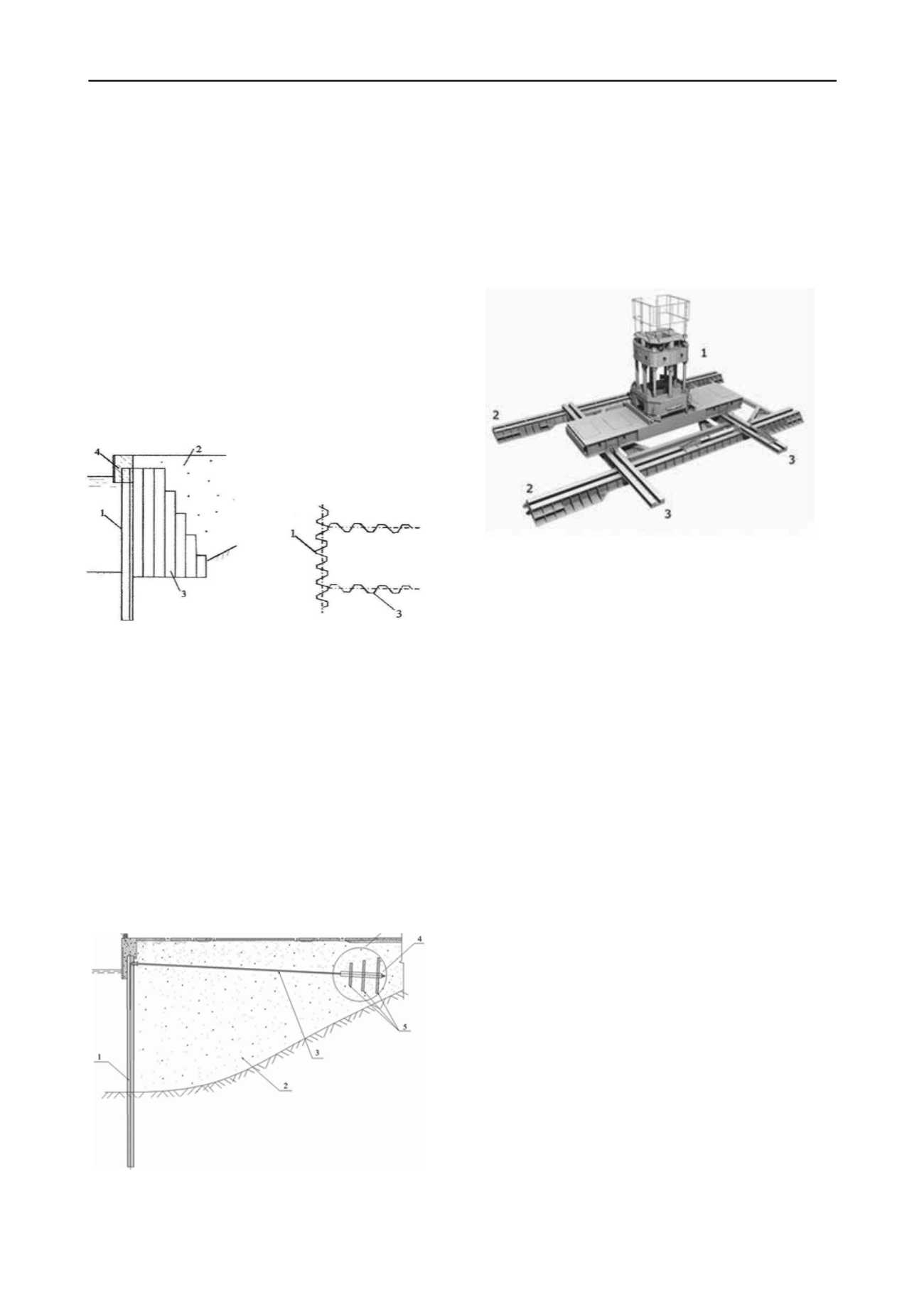
2648
Proceedings of the 18
th
International Conference on Soil Mechanics and Geotechnical Engineering, Paris 2013
4 INNOVATIVE SOLUTIONS FOR COASTAL
HYDRAULIC ENGINEERING
A new structure of the retaining wall has been worked out to
provide, firstly, resistance to heavy loads stipulated by soil
pressure behind the coastal sheet piled wall and, secondly,
simplifying of construction technology for deep water quay wall
due to absence of traditional anchor devices. Retaining wall
(Fig. 4) includes steel sheet piles installed along the structure,
soil backfilling behind the wall and transversal sheet piled rows
(counterforts) connected with axial wall. Counterforts are made
of sheet piles of different length and have a shape of rectangular
trapezoid. The length of the sheet piles in counterforts is
decreased according to the distance from the axial wall and
width of the transversal rows is increased downwards. Sheet
piles’ heads are joined by the cap. In such structure the idea of
counterforts is not only to increase a rigidity of the retaining
wall while withstanding the applied loads but also to reduce
effectively soil pressure behind the wall.
The basic research for full-scale physical modeling on press-
in and extraction equipment was based on the Modular Piling
System. This multifunctional equipment has been developed
with the intended purpose of implanting prefabricated
construction elements using the press-in method. The piling
system is equipped with the original hydraulic piling machine
(Fig. 6) with wedge-operated clamps (testing devise) and a
modular coordinating skidding system (MKS).
Figure 6. Modular section of the piling system MKS: 1 – press-in piling
machine; 2 – longitudinal guides (skid tracks); 3 – transverse guides
(cross slide).
Figure 4.
Sheet piling wall with counterforts: a
– cross-section; b –
plan. 1 – axial sheet piling; 2 – soil backfilling; 3 – sheet piled
counterforts; 4 – cap.
A new construction of the bulkhead is worked out to increase
the bearing capacity of the coastal protection wall or quay wall
as well as to reduce their material consumption (Fig. 5). The
structure incorporates the front wall and soil backfilling behind
it. Anchor bearers are made of “comb” type as several small
anchor plates fixed along the rigid core. Anchor force is taken
by all plates of the comb simultaneously. It provides increasing
of the bearing capacity both of the anchorage and of the
structure in whole (keeping the same material consumption for
the anchorage as at the traditional solutions with one large
anchor plate). On the other hand proposed structure may
provide decreasing of the material consumption (keeping the
same structure’s bearing capacity as at the known facilities).
In terms of its impact capability the piling machine is
completely quiet and vibrations in the ground are at an absolute
minimum allowing for the machine to work on certain highly
sensitive ground areas, extremely small spaces, and in historical
preservation areas. The strategic technological advantages of the
piling system are high productivity, precision and quality
control.
Depending on the features of the project, location of the piles
in terms of engineering and geological conditions of the site,
pressing construction elements into the ground could be
provided with the flow-line and coordinating installation
methods.
REFERENCES
Bruce D.A. An introduction to the deep soil mixing methods as used in
geotechnical applications. Report FHWA-RD-99-138 / D.A. Bruce.
– U.S. Dept. of Transportation, Federal Highway Administration,
2000. – 143 p.
Characteristics of manmade stiff grounds improved by drill-mixing
method / M. Zotsenko, Yu. Vynnykov, I. Lartseva, V. Shokarev, V.
Krysan // Proc. of the 15
th
European Conf. on Soil Mechanics and
Geotechnical Engineering “Geothechnics of Hard Soils – Weak
Rocks”. – Athens. – 2011. – P. 1097 – 1102.
Deep mixing research results in under water conditions / [W.F. Van
Impe, R.D. Verástegui Flores, P.O. Van Impe et. al.] // Proc. of the
16th Intern. Conf. on Soil Mechanics and Geotechnical Engineering
(Osaka, 2005). – Millpress Science Publishers Rotterdam, 2005. –
V. 3. – P. 1275 – 1278.
Larsson S. Mixing processes for ground improvement by deep mixing.
Doctoral thesis / S. Larsson. – Stockholm: Royal Institute of
Technology, 2003. – 218 p.
Figure 5. Anchored bulkhead with anchor bearer of new “comb” type:
1 – sheet piling; 2 – backfilling; 3 – tie-rod; 4 – rigid core; 5 - anchor
plates.
Stress-strain state of the system “base-strip foundation” at elimination
of excessive
tilts of buildings
/
V. Shokarev, V. Shapoval, V.
Chaplygin, R. Samchenko, D.Volkov
//
Proceedings of the 17th
International Conference on Soil Mechanics and Geotechnical
Engineering, Alexandria, Egypt, 2009. - Published by IOS Press
under the imprint Millpress, 2009. – V. 1. – P. 680-683.


